If your home is your castle, then a burglary or home invasion is like a castle breach. The good news is that the rates of property crime are down, according to both FBI and Bureau of Justice Statistics reports.
Property crime is more common than violent crime, according to the PEW Research Center, a non-partisan and nonprofit think tank. PEW notes that while property crime is down, larceny/theft and burglary are the most common crimes.

The FBI “Crime Clock” calculates that in 2018, a burglary happened every 25.7 seconds in the US. Plus, property crimes in 2019 accounted for estimated losses of $15.8 billion.

Some may worry that taking steps to protect their castle may be cost-prohibitive, but you can take many simple, common-sense precautions to keep your family and home safe. Note that home invasions are technically a subset of burglaries, in that home invasion includes forcible entry while someone is home. We will look primarily here at the prevention of any kind of unauthorized entry.
1. Use a Security System
Using a good security system is always a good idea. In a best case scenario, it will discourage anyone from even attempting to break into your home. If someone does try, an alarm will alert you, the neighbors, and the authorities. Some security systems will add motion detectors or even body-heat sensitivity to respond to any unexpected presence, inside or on the perimeter.

As with most preventative tips here, a security system is no guarantee. One drawback of a security system is that a truly determined criminal can often find a way to bypass it. They may even be in and out before the authorities arrive.
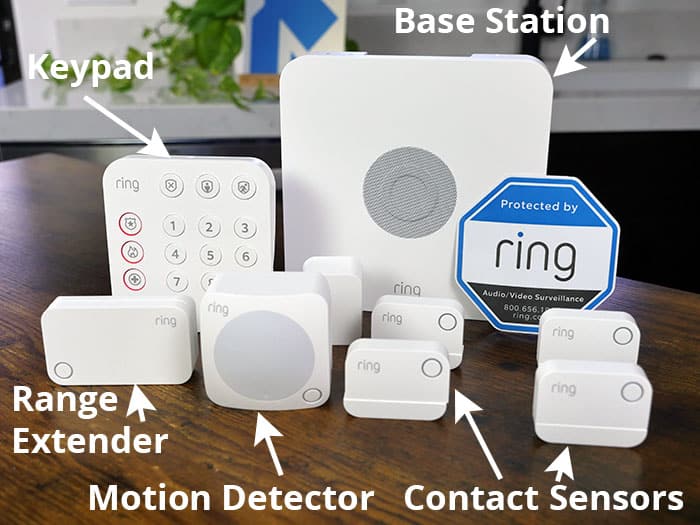
However, the idea is to make it as difficult as possible for them. The more deterrents you can throw in their way, the more likely it is that they will decide that your home is not worth the effort or risk, and move on.
Make sure that your security system is installed by a reputable company and keep it up to date to maximize its benefits.
RELATED – See our Frontpoint Security Review here.
2. Use Smart Home Tech
An alarm system is good. Even better—A security system with cameras. Adding video surveillance as part of your security system will make sure you can see who is outside. One that records and stores footage will help identify anyone who attempts unauthorized entry.

A video doorbell camera gives you the ability to see who is there without having to glue your eyeball to a peephole, answer the door, or even be home. Live video is streamed to your phone when the doorbell is rung or a motion sensor is triggered.
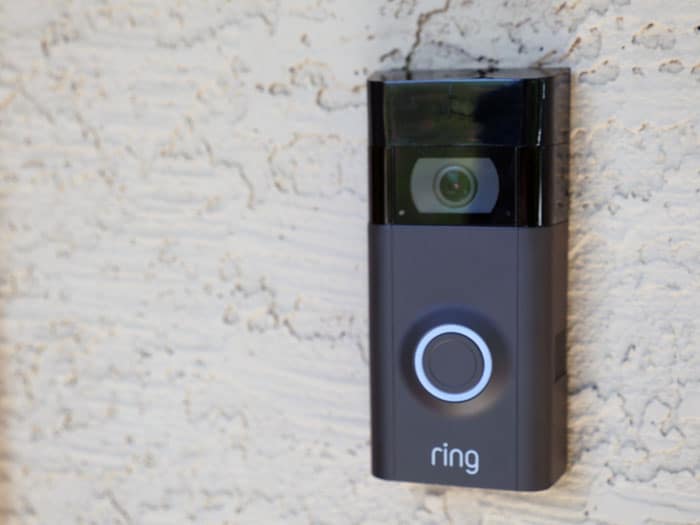
The latest models even offer a pre-buffer feature that allows you to see what happened a few seconds before the doorbell was pressed. Look for other features like facial recognition, motion sensors with customizable motion zones, and two-way audio.

Video doorbells often come as an add-on element of a home security system and use a system hub to connect to other elements like door locks, alarms, and lights. They don’t usually have dedicated storage, so you may have to use a cloud service to store and view your footage.
Smart locks are another great addition. They can be controlled remotely to schedule access. A simple one will allow you to open and close doors from your phone. More advanced versions let you designate specific privilege to various family members and friends.
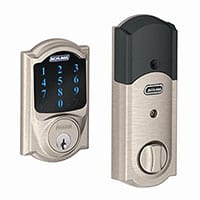

Others may use voice commands, connect with other smart home devices, or operate from a mobile app or desktop. Models can range from $100 – $300.
Opening sensors let you know anytime any door or window is opened or closed. As well as helping with security, this handy feature is good for parents with children and swimming pools, alerting you in case the kids have wandered outside unattended.

3. Use Security Lighting
Most experts agree that good lighting is a burglar deterrent. Well-lit homes won’t always deter a would-be intruder, but lighting the exterior of your home will make it that much harder for anyone to hide from video surveillance or watchful neighbors. Make sure to light the yard, the garage, and as many entrances and exits as possible.

Motion-activated lights will alert you quickly if someone is near your home. An unexpected flood of light can startle a would-be criminal, especially if accompanied by loud alarms.
Be careful if lights are on a timer. Burglars studying potential targets will notice if the lights always go on at the same time every day, indicating your schedule. If possible, vary your lighting schedule. Combining lighting with noise from inside the home, such as TV or radio, will further confuse anyone trying to determine the exact times someone is home.
Smart bulbs offer both convenience and the option to operate lights remotely. Some use built-in Wi-Fi and a router connection, allowing you to connect via the cloud. Others use Bluetooth and connect with your phone which may require you to be within 50 feet if not using a Wi-Fi hub.

Use Amazon Alexa, Google’s Assistant, or Apple’s Siri to sync and schedule your lights (and even perhaps TV and radio). Creating activities like this remotely and with some irregularity can make it seem more like someone might be home.
4. Know Your Neighbors
The best security system and lighting design can be bypassed if someone has the motivation and skill set. But what the overwhelming majority of would-be intruders do NOT want to face is nosey neighbors. In 2016, a local New York NBC affiliate aired a series in which they interviewed incarcerated burglars and surveyed hundreds with questionnaires on the hows, whys, and wheres of their criminal strategies.

Those surveyed often referred to being noticed by neighbors as the most effective deterrent. While they could potentially be in and out before authorities come, or distract dogs with food and treats, no one really wanted to deal with being questioned by friendly yet nosy neighbors who could identify them.
Whether it be a neighborhood watch, or just being friendly with neighbors and knowing who lives in the area versus who is a stranger—neighbors are one of your best defenses.
5. Reduce Hiding Spots
Make sure to keep trees and bushes trimmed to eliminate hiding places. This also makes your house look lived-in and therefore less likely to be targeted. Gazebos, kids’ playground equipment, landscaping features—all these can provide shelter, so make sure they are well-lit and not too close to the walls and entrances.
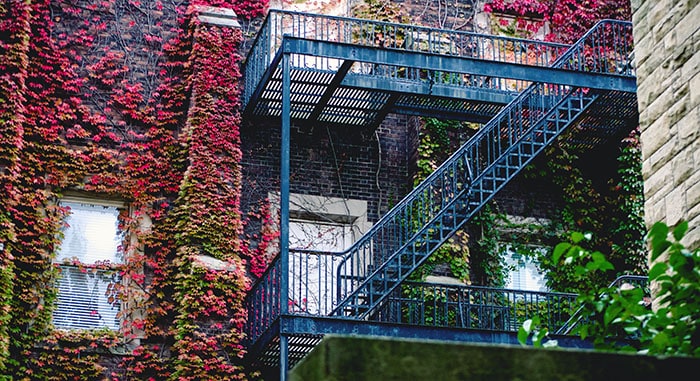
Think about second story windows as well. High trees near the house can provide easier access by an agile criminal willing and able to climb.
6. Use Common Sense
Trust your instincts. Don’t open doors if you don’t feel comfortable. It’s okay to ask for identification and make people wait while you check it out. Most appointments are scheduled in advance, so if someone shows up unexpectedly, they won’t mind waiting if they are on legitimate business.
If you do answer the door, yell something as simple as “I’ll get it” to indicate that someone else is with you. Never tell anyone if you are there alone.

Always lock doors and windows. People too often get complacent thinking that their neighborhood is safe—which it may be, but it only takes one intruder to change your life.
Get good, solid locks. Put them on thick, solid doors.

Keep your garage closed. No need to show off your fancy car or all your tools. Or give anyone an easy way to get inside. Or hide in waiting for you to get home.

Don’t leave an easy-to-find key outside. Burglars know to look for keys in fake rocks and other places near the door, and will watch to see where you get a key.
Do place an inexpensive dowel rod in the track of any sliding door or window to keep it from opening. A burglar willing to sneak in may not be as willing to risk it if they have to break glass, creating noise that draws more potential attention.
7. Get a Dog
A dog can both warn you and scare intruders. A determined thief might come prepared with treats or peanut butter to quiet a dog, but many simply aren’t that organized. Having a dog (or a sign that says “Beware of Dog”) adds an extra level of uncertainty and effort required.

The more you can raise questions in the mind or would-be criminals, the more likely they are to move on.
8. Protect Your Privacy
Close blinds so that people can’t easily see inside. You can also use decorative privacy film to further reduce what can be seen from outside. These films are inexpensive and come in all patterns, styles, and sizes.
Note: Privacy film can also refer to clear security film that covers glass windows and doors, making it both more difficult to break through as well as keeping all the pieces together if there is a break. This makes any cleanup easy, whether the break comes from rocks, objects, or fists of someone trying to break in, or a more innocent stray baseball. This film does not block anyone’s vision in or out, but some versions of it do block UV rays and reduce heat. This kind of glass protection film can be more expensive (anywhere from $30 to $400) but also stronger.
When shopping for privacy film, just know if you are looking for more decorative film that blocks people seeing in and adds to your décor, or the invisible, clear film like this that strengthens glass. Both add to your security in different ways.
Break down your boxes. People do go through recycling and trash to see who might have just made expensive new purchases. At the very least, take off the shipping/name label, which also may prevent potential identity theft.
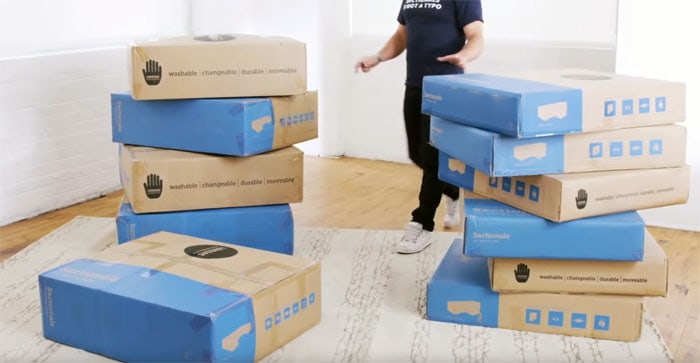
9. Protect Your Valuables
Burglars usually want to be in and out as fast as possible. According to ADT and the FBI, an average burglary lasts eight to ten minutes, some lasting only 90 seconds.
With such a limited time, burglars usually go for:
- Cash/wallets/credit cards
- Guns
- Jewelry
- Prescription drugs
- Electronics
- Documents (less likely in a basic smash-and-grab, but still worth protecting against identity theft)
Hide your valuables inside in a safe or lockbox. Even better, anchor the safe in a wall or floor. Sometimes thieves will simply take the whole unit and break it open elsewhere.

Try inventive hiding spots. Burglars know to look for valuables in the bedroom and freezer. Try using mislabeled boxes, old VHS tape cases, or false books. No one wants to spend time going through “Tom’s Old Toys” or “Fiddler on the Roof 1998”.
Use multiple hiding spots. Leave some things you don’t care as much about in the open, and spit the rest up into a few different stashes. That way, even if they find one, it’s unlikely they will stay long enough to look for more. This applies to important documents as well. Just be sure to remember what you put where.
10. Keep Your Home Looking Lived-In
Burglars often avoid attempting a break-in when it appears that someone is home. Be aware of anything that might indicate when you are gone. Even a short time away from home can offer clues that your home is empty, making it an easier target.
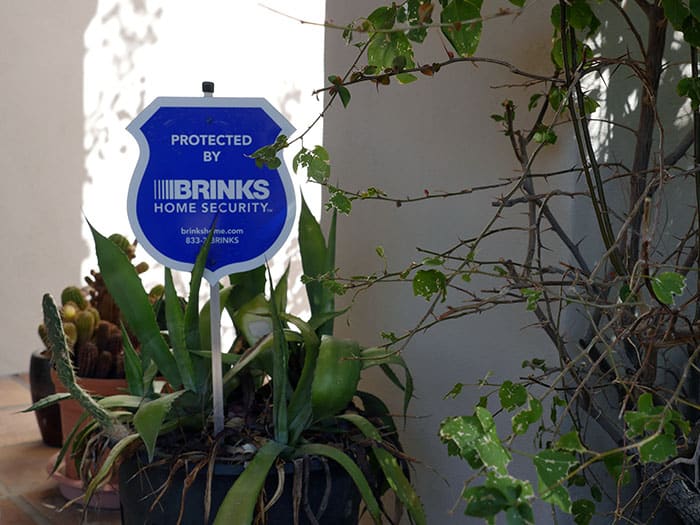
A few things you can do to make your home look occupied when you are gone include:
- Putting a hold on your mail if your mailbox is in a visible location. Days worth of letters, magazines, or papers stacking up is a sure sign of an empty house.
- Having a trusted neighbor or relative park in your driveway once in a while, or move your cars around.
- Arranging to have the garbage bins set out on the appropriate day. One house on a street with no garbage can out on garbage pickup day can be glaringly obvious—and may peak the interest of someone looking for an easy target.
- Arranging to have the walkways shoveled in winter (for the same reason).
- Putting lights on timer—preferably on a system that allows you to vary the schedule, as mentioned above. Remote access through a smart system is helpful, but even a basic timer is better than nothing. What you don’t want is complete darkness for an extended period of time while you are gone—or for any outside or visible inside light to be on 24/7. Both are dead giveaways that no one is home.
- Adding sound into the mix. Whether you have remote access to periodically turn on the TV or radio, or go old school and have a friend go over to change up the sound occasionally, adding sound will make your home seem lived in.
11. Be Careful with Social Media
As much as you might want to share your fun and excitement while on a trip, avoid doing so online until you have returned. Criminals actually do watch online to see when people talk about leaving. Depending on your social media activities and settings, do you really know and fully trust every single person who might be seeing every post you make?

Maybe you do. But as one criminal noted in the news series mentioned earlier, people you do know can talk to or get overheard by people you don’t know. It may be surprisingly easy for them to track down the “friend of a friend who said his brother was on vacation in Hawaii and happens to have just bought a new car.”
If you can delay the instant gratification of posting pictures, or at least tagging your locations, while away from home, you just might increase the security of that home.
This goes for bragging too much, especially online, about recent expensive purchases as well. You don’t have to be paranoid, just careful about who you share what with, and when.
Home Invasions
Tactics to handle a home invasion (break-in while someone is in the house) are deliberately outside the scope of this article.
A few general common-sense ideas can be offered:
1. Make a Plan
Make a plan and make sure everyone in the family knows it. It may mean everyone going to a specific room (with a phone) that can be blockaded until the authorities arrive, or since you know your house better than an intruder, making your way outside and escaping.

Practice it. In adrenaline filled situations, motor control and cognitive function often become impaired unless you are practiced in staying calm.
2. Don’t Fight the Intruder
Don’t engage an intruder. Objects can be replaced; your loved ones can’t. Most law enforcement and security experts agree that intruders don’t usually want to engage and will run if startled mid-crime.
But if you attempt to engage, they are likely to engage back. You may get more than you bargained for especially if you are untrained and unpracticed in dealing with life-threatening situations.
Those same experts agree that avoiding a violent encounter and staying safe is your first priority.
3. Self-Defense
Get creative when considering weapons for worst case scenarios. People sometimes think a gun is the only option for defense. But a taser or pepper spray, for example, are far less expensive, will still stop an intruder, and are less likely to result in a tragic home accident.

Plus, if your own weapon gets used against you, you are more likely to survive. Even a blinding flashlight or high pitched siren may incapacitate someone long enough for you to escape.
If you do have a firearm, or any weapon for that matter, make sure you and all appropriate family members are trained in how to use and store it safely.
Consult legal, security, or military experts for more specific information, strategies, and training related to home invasions.
Concluding Thoughts
Your home is your castle and of course you want to protect it, yourself, and your loved ones. Remember that no one preventative measure is guaranteed to work in all cases, but the more difficult you can make it for would-be intruders, the better. Be wise and prepared so that you can relax and enjoy your castle.
Installing a good security system tailored to your needs, applying some common-sense precautions, and thinking ahead can give you peace of mind and greatly reduce the likelihood that you will have to deal with any worst-case scenarios.
